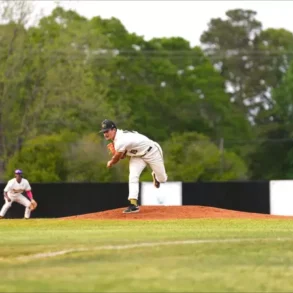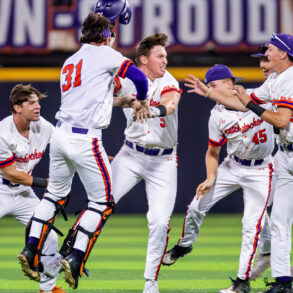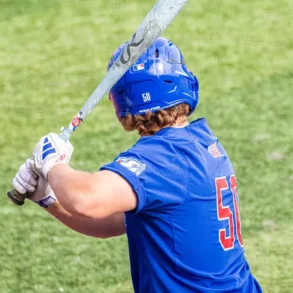
Tennessee’s baseball team is firmly among the sport’s elite. The Volunteers are the reigning national champions and have produced six first-rounders in the last five MLB Drafts.
The list of flamethrowers who spent time in Knoxville over the past half decade is extraordinary. Angels reliever Ben Joyce is one of three pitchers in MLB history to throw 105 mph, and his 105.5 mph fastball last September was the hardest pitch ever that resulted in a strikeout.
Rockies righthander Chase Dollander made his big league debut this season and is already averaging 97.7 mph with his heater. Reds prospect Chase Burns—who spent his first two seasons in Tennessee before transferring to Wake Forest—brought his fastball up to 102 mph this spring.
Red Sox ace Garrett Crochet—a first-round pick of the White Sox in 2020—averages nearly 96 mph, making him one of the hardest-throwing southpaws in the sport.
This year alone, the Vols have three pitchers whose fastballs have touched 100 mph or harder: Saturday starter Marcus Phillips and relievers Tanner Franklin and Nate Snead.
And then there’s Liam Doyle.
The lefthander’s fastball hasn’t quite gotten to triple-digits this season—his best bolt is a mere 99 mph—but it remains one of the best pitches of its kind found anywhere across the country.
So, what makes Doyle’s fastball so special? Let’s let him explain it.
“There’s a few pitchers out there that have better vertical fastballs than me, but I throw mine with conviction, I get good ride on mine and I throw from a different arm slot,” Doyle said. “I’m a lefty, so it’s kind of funky for a lot of people to see, and it just comes off my hand differently than a lot of other pitchers throw.
“So, you know, I think it’s the best fastball in the country.”
The results certainly back up Doyle’s assertion.
Doyle throws the pitch—which averages 95.9 mph—69% of the time, to impressive results. Through April 14, he’d thrown 588 fastballs and had thoroughly neutralized hitters, who’d produced a line of just .139/.250/.235. Sixty-nine of his NCAA-leading 95 strikeouts this season have been finished with fastballs.
Tennessee pitching coach Frank Anderson has been with the Volunteers since 2017 and been coaching in general since 1984, when he joined his alma mater Emporia State as an assistant. In that time, he’s seen a great deal of impressive fastballs. Asked if Doyle’s heater matched up with any he’s seen in his decades in the game, Anderson didn’t have to go deep into the memory banks.
“It probably compares to Dollander’s,” Anderson said, “because his sophomore year here, his was special, just like (Doyle’s), where you could know he was throwing a fastball and still have a hard time catching up and putting it in play. I mean, I saw him beat Dylan Crews in a conference tournament where we all knew what was coming—and so did he—and he just threw it by him. I think the next at-bat he probably doubled off of him or something, but the first at-bat, that was hard to do with those types of guys.”
In his draft year at Tennessee, Dollander threw his fastball 65% of the time, and the pitch averaged 95.7 mph. Doyle throws his fastball with a touch more velocity and a bit more often, but life on both pitches is similar.
“The ride on those two guys’ fastballs is very comparable,” Anderson said. “Crochet had more lateral movement and Burns, he had some ride, but not like these two (Doyle and Dollander).”
When MLB commissioner Rob Manfred calls Doyle’s name in July, he’ll announce him as a lefthanded pitcher from the University of Tennessee. That’s only part of the story. A third of it, in fact.
Upon graduating from high school in New Hampshire, Doyle began his college career at Coastal Carolina. After striking out 69 hitters in 56.1 innings with the Chanticleers, Doyle moved to Ole Miss for his sophomore year. His work in Oxford caught the attention of the staff at Tennessee, which added him to a roster of a team with an eye on a second-straight national title.
With six weeks left in the regular season, Doyle is already 11 strikeouts past his total from his previous high-water mark of 84 from a season ago with Mississippi when he went 3-4, 5.73 and allowed nearly two home runs per nine innings. Now, Doyle’s strikeouts are up, his hits and walks are down and he’s done a much better job keeping the ball in the park—no small feat in this era of college baseball.
So, what changed? A lot, including some more velocity behind his mix.
“My offspeed pitches are different than last year,” Doyle said. “My fastball stayed the same—we haven’t touched it. I’ve always had a pretty good fastball, but my slider grip is a little bit different. I throw it a little bit harder, and I’m trying to throw it more like my fastball.
“The problem with it last year was that my arm slot was a little bit different, so hitters would pick up on it quicker. It was a pretty good pitch still, but it just came from a different arm slot, so hitters would be able to pick up on it quicker. And then my split is more like a split-changeup grip than a true splitter.”
The changeup’s overhaul has shown itself in a variety of ways. The grip is different, which is a change designed to make it leave Doyle’s hand in a way that more closely mirrors his wicked fastball. The pitch is harder, too, sitting around 86 mph and peaking a few ticks hotter. The changeup he threw in 2024 averaged roughly 80 mph and peaked at 85.
About the only pitch Doyle didn’t revamp was his fastball. And why would he? Even when his surface numbers weren’t pristine, his fastball was earning rave reviews from people in high places.
When he faced Tennessee in 2023 as a member of Ole Miss, Doyle caught the eye of Christian Moore, one of the best hitters in the nation that year and a first-rounder in waiting. Doyle threw Moore eight fastballs that afternoon and got Moore to swing through five of them. Two of those whiffs resulted in strikeouts.
Doyle was one of just two pitchers in the country that season to get Moore to strike out multiple times on fastballs.
Just months away from this year’s draft, Doyle has used an amplified arsenal and a reshaped body to turn in the best results of his life. And when he takes the hill for the first time in a minor league game, he’ll add his name to a scintillating list of Volunteers who’ve parlayed exemplary fastballs into professional careers.
This post was originally published on this site be sure to check out more of their content.





